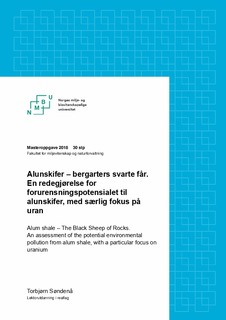| dc.contributor.advisor | Oughton, Deborah | |
| dc.contributor.advisor | Holmstrand, Marte | |
| dc.contributor.author | Søndenå, Torbjørn | |
| dc.coverage.spatial | Norway | nb_NO |
| dc.date.accessioned | 2019-04-03T13:31:52Z | |
| dc.date.available | 2019-04-03T13:31:52Z | |
| dc.date.issued | 2018 | |
| dc.identifier.uri | http://hdl.handle.net/11250/2593192 | |
| dc.description.abstract | It has been acknowledged for a long time, that alum shale is a rock that causes trouble. Already in 1957, reports said that the rock caused technical problems, because it started to swell beneath buildings. An even greater problem has occurred later on; alum shale is an acid producing rock, and on top of acid production, uranium and some heavy metals leaks from it. Because of the environmental pollution potential of alum shale, excavated alum shale is required to be deposited in suitable landfills.
Every year in Norway, about 11 000 tonnes of alum shale is deposited in landfills. The reason for this amount, is that Oslo, Akershus, Hedmark, Oppland and Buskerud all have significant levels of sub-surface alum. The alum shale is removed because of construction activity.
The environmental pollution potential of alum shale is caused largely by high concentrations of uranium. Deposited alum shale has an activity of 0,5 – 5 Bq/g, usually around 1 Bq/g.
Leaching of uranium occurs in combination with to acid production and change in the redox state of uranium species. When the sulphides in alum shale oxidises, sulphuric acid is produced. The acid production escalates the weathering and mobilises several heavy metals that were earlier bound with sulphides. Due to oxidising conditions, uranium is transformed to the highly mobile hexavalent uranyl ion.
Measures to counteract the environmental pollution potential of alum shale, are today based on preventing the initial oxidation process of sulphides. If this oxidation process is blocked, leaching of uranium will be reduced.
Analysis of experimental data from NOAH suppurts the hypothesis that acid and redox changes are accompanied by uranium leaching, but also suggest that leaching of uranium is not the only problem. Even though uranium leaching alone was sufficient to harm both plants and animals in fresh water, the problem is far more complex. Increase in several heavy metals was also seen and at levels that exceed the guidline values proposed by Norwegian Environment Agency for fresh water, and WHO’s guidelines for drinking water.
In addition, the measured pH in the leaching water suggestedt that pH can reach levels beneath 3 which could cause harm to a given ecosystem. | nb_NO |
| dc.description.abstract | Det har lenge vært kjent at alunskifer er en bergart som skaper problemer. Allerede i 1957 var det rapportert om byggetekniske skader som oppstod på grunn av alunskifer som sveller. Et større problem har meldt seg i nyere tid; alunskifer er en syredannende bergart, og som i tillegg til syredannelse lekker ut uran og diverse andre tungmetaller. På grunn av forurensingspotensial knyttet til alunskifer er det satt som krav at oppgravd alunskifer skal deponeres i egnet deponi.
Det deponeres årlig rundt 11 000 tonn alunskifer i Norge. Dette skyldes at alunskifer ligger opp i dagen flere steder i og rundt Oslo, Hedmark, Oppland, Buskerud og Akershus, og fjernes på grunn av byggeaktivitet.
Forurensingspotensialet til alunskifer skyldes et høyt innhold av uran. Deponert alunskifer har en naturlig aktivitet i intervallet 0,5 – 5 Bq/g, som regel rundt 1 Bq/g.
Utlekking av uran er knyttet til syredannelse og redokstrinn til uranspecier. Det blir dannet svovelsyre når sulfider i alunskiferen oksiderer. Syredannelsen eskalerer forvitring og mobiliserer flere tungmetaller som tidligere var bundet i sulfidene. På grunn av oksiderende miljø foreligger uran som seksverdig uranylion, og er meget mobilt.
Tiltak for å motvirke forurensingspotensialet til alunskifer baseres i dag på å stanse innledende oksidasjon av sulfider i alunskiferen. Stanses innledende oksidasjon, stanses utlekking av uran.
Det viser seg imidlertid at uran ikke er problemet alene når det kommer til alunskifer. Tilgang på et utlekkingsforsøk utført hos NOAH Langøya viste at selv om uranutlekking alene er nok til å skade planter og dyr i ferskvann, er problemet langt mer kompleks. Flere tungmetaller som ble målt lekket ut i forsøket, overstiger grenseverdier satt av miljødirektoratet for ferskvann og grenseverdier for drikkevann satt av WHO.
I tillegg kan pH i sigevannet skape problemer for et gitt økosystem, da målt pH i forsøket var lavere enn 3. | nb_NO |
| dc.language.iso | nob | nb_NO |
| dc.publisher | Norwegian University of Life Sciences, Ås | nb_NO |
| dc.rights | Attribution-NonCommercial-NoDerivatives 4.0 Internasjonal | * |
| dc.rights.uri | http://creativecommons.org/licenses/by-nc-nd/4.0/deed.no | * |
| dc.subject | Forurensning | nb_NO |
| dc.title | Alunskifer : bergarters svarte får : en redegjørelse for forurensningspotensialet til alunskifer, med særlig fokus på uran | nb_NO |
| dc.title.alternative | Alum shale : the black sheep of rocks : an assessment of the potential environmental pollution from alum shale, with a particular focus on uranium | nb_NO |
| dc.type | Master thesis | nb_NO |
| dc.description.version | submittedVersion | nb_NO |
| dc.subject.nsi | VDP::Matematikk og Naturvitenskap: 400::Kjemi: 440 | nb_NO |
| dc.description.localcode | M-LUN | nb_NO |

